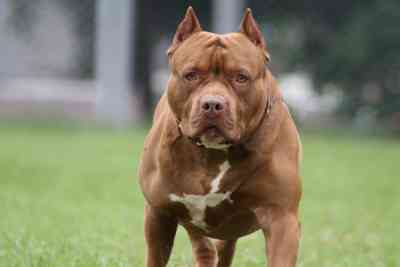Certainly, encountering an unknown dog that appears provoked can be a frightening experience, especially if it belongs to one of the larger breeds. Dogs, being social animals, have the ability to sense and respond to human emotions. If they perceive fear or apprehension from humans, they may exhibit defensive behaviours such as barking or growling as a warning sign.
Table of Contents
It is worth noting that some dogs may be naturally more vocal than others, either due to their breed tendencies or individual personalities. However, it’s important to remember that dogs can bring immense joy and companionship into our lives. Many people find them to be incredibly sweet pets, offering loyalty and affection in various ways, from their unwavering companionship to their enthusiastic kisses.
If you ever feel nervous or uneasy when encountering a dog, know that you are not alone in experiencing such feelings. Certain breeds have been selectively bred to possess protective qualities, which can contribute to a heightened sense of caution. It is always advisable to approach unknown dogs with caution and respect, allowing them their space and observing their body language for any signs of aggression or discomfort.
An Introduction To Scary Dogs
Encountering a scary dog can be a terrifying experience that leaves you feeling helpless and vulnerable. It’s important to remember that these animals can come in all shapes and sizes, and often display a range of aggressive behaviours that can be very difficult to predict.
Whether you’re out walking your own dog or simply going for a jog in the park, it’s always a good idea to keep a safe distance from any animal that you don’t know and stay aware of its behaviour at all times.
Remember, even the most seemingly docile dog can become defensive in certain situations, so it’s best to avoid any unnecessary contact and keep yourself out of harm’s way.
What Makes a Dog Scary?
The perception of a scary dog can be influenced by various factors, including size, breed, and temperament. Generally, larger dogs may be perceived as more intimidating due to their size and strength. However, specific breeds such as Pit Bulls, Rottweilers, German Shepherds, or Doberman Pinschers may be regarded as scary even when they are small puppies due to their reputation or stereotypes associated with their breed.
The demeanour and behaviour of a dog play a crucial role in how they are perceived. Aggressive behaviour or a strong aversion to strangers can create anxiety and fear for all parties involved. Responsible dog owners should prioritize training and socialization to ensure their pets can interact safely with people and minimize the potential for threatening situations.
It is important for both dog owners and individuals encountering dogs to understand the behaviours that may make a dog appear scary or disconcerting. By having this awareness, precautions can be taken to ensure the safety and well-being of everyone involved.
The Most “Scary” Dogs and Why
While it’s true that some dog breeds have been unfairly deemed as “scary,” it’s important to understand that their appearance doesn’t dictate their behaviour. Doberman Pinschers, Rottweilers, Akitas, and Pitbulls are just a few examples of breeds that have received negative attention due to their size and strength, but it’s crucial to understand that their temperament is largely influenced by training and socialization.
Proper socialization from a young age is key to ensuring the development of a well-adjusted and friendly companion, regardless of breed.
#1 Pit Bulls

The history of Pit Bulls traces back to England, where they were initially bred for bull and bear baiting. Although these activities became illegal in the 19th century, Pit Bulls remained popular among dog enthusiasts for their robust build and strength. Unfortunately, Pit Bulls often have a negative reputation despite their friendly disposition towards humans.
One reason for this is their large and muscular physique, which can be intimidating to some. On average, adult Pit Bulls range from 18 – 22 inches in height and weigh between 30 to more than 70 pounds. These impressive physical traits, combined with their short, close-lying fur in assorted colours, contribute to the formidable look of a Pit Bull.
However, it’s important to note that their appearance does not necessarily reflect their personality, as they are affectionate and loyal companions when well-trained and socialized.
#2 Rottweilers

The Rottweiler breed is one of the most distinct and recognizable breeds in the world and for good reason. Originating from Germany, these dogs were bred to work as herding and guard dogs on farms, using their impressive strength and musculature to protect their territory and keep animals in line.
Despite their intimidating appearance with broad heads and muscular frames, many who have spent time with Rottweilers note their gentle and affectionate nature, especially when properly trained and socialized.
While they may look like fierce protectors at first glance, Rottweilers are known for their loyalty and deep bonds with their families. These are dogs that require attentive and loving care and in return, they offer their unwavering devotion and protection.
#3 German Shepherds

German Shepherds have overcome their infamous reputation as scary dogs to become a cherished pet breed worldwide. Originally bred for sheep herding in Germany, this regal breed’s brilliant intelligence and unwavering loyalty make them ideal companions for families.
At around 22-26 inches tall and weighing between 50-90 pounds, both genders have similar stature, with a thick double-layered coat of straight, guard hairs and woolly undercoat to keep them warm in colder weather. These loyal companions come in many colours, though their traditional tan and black look is often the most sought-after.
#4 Doberman Pinschers

Doberman Pinschers, also known as Dobes, are a fascinating breed of dog that was originally developed in the 1890s by a German tax collector who needed a strong guard dog. These medium-sized dogs have short hair, stand around 24 to 28 inches tall and weigh between 60 to 90 pounds.
With their upright ears and curved tail, they are easily recognizable, but it is their dark coat that often adds to their intimidating appearance. While Dobes may seem scary to some, they can actually be quite friendly and loyal when properly socialized. In fact, they make great family dogs, but always remember to supervise them when around children because of their size and strength.
#5 Chow Chows

Chow Chows, originating from China, are a unique breed that has been around for centuries. Originally bred as working dogs, these fluffy furballs were used to pull carts and guard camps and compounds. Today, Chow Chows are primarily kept as pets due to their fiercely loyal personalities.
However, despite their small size, these dogs can look quite intimidating. With their dense double coating of fur, ranging in colours such as red, black, blue, and cream, plus their large round heads and dark eyes set back into small ears, Chow Chows can be mistaken for being more ferocious than they really are.
Despite their somewhat frightening appearance, these dogs are generally docile and make excellent companions if given proper training and socialization.
#6 Siberian Huskies

Siberian Huskies may look intimidating due to their resemblance to wolves, but it’s important not to judge a book by its cover. These dogs are known to be playful and loyal companions, often forming close bonds with their owners.
Originally bred in Siberia and North-Eastern Russia, they were specifically trained to help with tasks such as herding reindeer and pulling sledges through harsh snowy conditions. Despite their origins in cold climates, they can thrive in other regions as well.
It’s worth noting that Siberian Huskies come in a variety of colours and patterns, making them quite striking to look at. Additionally, they tend to have blue or brown eyes, creating an even more distinctive look.
Description of Their General Appearance and Personality
Scary dogs, particularly those of larger breeds, can indeed be intimidating due to their physical attributes and protective instincts. These breeds have been selectively bred to possess traits that make them well-suited as guardians. Their powerful, muscular bodies, broad chests, thick necks, and square muzzles contribute to their imposing appearance. Additionally, their intense stare and alert expression, along with fur that may stand up on end, further enhance their intimidating presence.
In terms of personality, scary dogs often display strong territorial instincts and protection-oriented behaviour towards their owners. They are likely to react when strangers enter their territory, often barking loudly and showing signs of aggression such as snarling or growling. These dogs have a no-nonsense attitude and will stand their ground when faced with intruders or unfamiliar individuals. Their loyalty to their family’s safety is unwavering, which contributes to their effectiveness as protectors.
Aside from their physical and protective traits, scary dogs also possess certain behavioural qualities that set them apart from other canines. They tend to be independent thinkers, preferring to make decisions on their own without constant guidance. Consistent training is necessary to bring out their best performance. Furthermore, they often form a deep bond with a specific person rather than the entire family, highlighting the importance of meeting the owner’s companionship needs to keep the dog content.
While scary dogs can be intimidating, with proper training and care, they can become loyal and excellent protectors for their owners and their homes.
Why Are These Dogs Considered Scary?
The fear of scary dogs is a common sentiment among many people, particularly when it comes to larger breeds such as Rottweilers, Pit Bulls, German Shepherds, and Dobermans. These dogs are known for their strong presence and imposing size, which can intimidate even the bravest of individuals.
Additionally, these breeds are often trained to be a guard or working dogs, which can result in a more aggressive disposition than other, more common breeds. Unfortunately, our fear is often perpetuated by popular culture and media, which tend to portray these dogs as dangerous and aggressive. It is important to remember that not all dogs are the same, and with proper training and socialization, any breed can make a loving and loyal companion.
What To Do If You Encounter a Potentially Dangerous Dog
Encountering an unknown and potentially dangerous dog can be a scary situation, but it’s important to stay calm and use your best judgment. Simply staring the dog in the eyes or moving too quickly can be interpreted as a challenge. Instead, take slow steps back without making any sudden movements.
If possible, try to identify the owner and ask them to control their dog. In situations where there is no owner present, it’s necessary to use a stern voice to call out commands like “No,” “Sit,” or “Stay.”
However, if none of these tactics is effective, it’s best to leave the area while still maintaining awareness of your surroundings. It’s crucial to remember that staying calm and using your best judgment can make all the difference in a potentially dangerous situation.
What To Do In the Case of a Dog Bite
If unfortunate enough to be bitten by a dog, regardless of its perceived scariness, it is crucial to handle the situation calmly and take appropriate steps. Here are some guidelines to follow:
- Move away: Safely and quickly distance yourself from the dog to prevent any further bites or injuries.
- Clean the wound: Thoroughly wash the wound with soap and warm water for at least 5 minutes. This helps reduce the risk of infection.
- Apply an antibiotic cream: If available, apply an over-the-counter antibiotic cream or ointment to the wound after cleaning. This can further aid in preventing infection.
- Control bleeding: If there is bleeding from the wound, apply gentle pressure using a clean cloth or bandage until the bleeding stops.
- Seek medical advice: Contact your doctor or visit the nearest hospital or medical facility as soon as possible. They will assess the severity of the bite and determine if further medical treatment is necessary, such as a tetanus shot or stitches.
Remember, even if the dog appears scary or intimidating, it is important to remain calm and prioritize your safety. Seeking medical attention promptly ensures proper care and reduces the risk of complications.
Training a Scary Dog For Protection
Training a scary dog for protection does not necessarily require more complexity than training other breeds. However, it does demand consistency, patience, and a keen understanding of your dog’s body language. Here are some tips for training a scary dog for protection:
- Start with basic obedience commands: Begin training with fundamental commands like sit, stay, and come. Keep the training sessions short and positive, using treats or rewards to reinforce positive behaviour.
- Progress gradually: Once your dog has mastered basic obedience, gradually introduce specific protection commands like “guard” or “watch.” It’s important to give these commands when your dog is calm and focused, as this will enhance their effectiveness.
- Discourage aggression: Training a scary dog for protection should not involve encouraging aggressive behaviours such as growling or barking at strangers. Instead, focus on teaching your dog to recognize danger signs and react appropriately without being overly aggressive.
- Positive reinforcement: Reward your dog for good behaviour during training sessions regularly. This positive reinforcement helps reinforce the desired behaviours and encourages your dog to continue responding positively.
Remember, training a dog for protection should prioritize safety and responsible ownership. Seeking guidance from a professional dog trainer experienced in working with protective breeds can be beneficial to ensure effective and responsible training techniques are employed.
The Importance of Trust and Bonding
When it comes to selecting a guard dog, trust and bonding are two of the most vital components for a successful relationship between dog and owner. These animals need to feel comfortable and at ease around their human family, in order to act as an effective protector.
Therefore, it is imperative to establish a relationship built on trust and mutual respect before introducing your dog to your family or guests. Providing opportunities for socialization with people and other animals can significantly increase their confidence and reduce the likelihood of aggressive behaviour. It is equally important to avoid overwhelming your dog with too many unfamiliar faces or situations.
Key Points
- Encountering a scary dog can indeed pose a safety concern, particularly when unfamiliar with the breed or its aggression level. Size, breed, and temperament are factors that can contribute to a dog being perceived as scary.
- Larger dogs are often seen as more intimidating due to their size and strength. Breeds specifically bred for protection may possess traits and characteristics that make them well-suited as guardians. These dogs may have a powerful, muscular build with a broad chest, thick neck, and square muzzle. Their coats may be short and their colouration may include sharp contrasts like black, brown, or white.
- When approaching or dealing with a scary dog, it is essential to remain calm and avoid making direct or prolonged eye contact, as this can be interpreted as aggression by the animal. Maintaining a non-threatening posture and giving the dog space is crucial to avoid escalating the situation.
- It is important to remember that each dog is an individual, and not all dogs of a particular breed or size will necessarily be aggressive or pose a threat. Responsible dog ownership, proper training, and socialization are key in ensuring that dogs of any breed or size can be well-behaved and safe in various situations.
FAQs
What is the most feared guard dog?
Known for their muscular build and powerful bite, Rottweilers have earned a reputation as fierce protectors. While they may be loyal and affectionate towards their owners, they can also be territorial and aggressive towards perceived threats. Their imposing presence alone is often enough to deter potential intruders.
What’s the most aggressive dog?
When it comes to aggressive behaviour in dogs, certain breeds tend to display this trait more commonly than others. However, it is important to note that aggression can be seen in any breed regardless of its reputation. Nevertheless, the most aggressive dog breeds include Pit Bulls, Rottweilers, German Shepherds, Siberian Huskies, Doberman Pinschers, and Chow Chows.
What is the cutest dog in the world?
When it comes to the cutest dog in the world, opinions are varied and can be subjective. However, some breeds are widely recognized for their adorable appearance. One such breed is the Pomeranian, with their fluffy coats and tiny size, they are hard to resist.
Final Words
Dog breeds are fascinating creatures, and like any other animals, some breeds can elicit fear in humans due to their looks or potentially being aggressive. Five of the most commonly referred to scary dog breeds include pit bulls, rottweilers, German shepherds, Doberman pinschers, chow chows, and Siberian huskies.
Although they can excel at being guard dogs, they can be intimidating for those who are unfamiliar with their nature. It is important to be cautious around dogs that appear hostile or have a history of being aggressive. If you are considering owning one of these breeds, it is essential to conduct extensive research on their temperament and maintenance requirements.
Reference:
- https://paradepets.com/dogs/cutest-dog-breeds
- https://www.usatoday.com/story/news/2023/03/22/worlds-biggest-dog-breed/11480217002/
- https://economictimes.indiatimes.com/news/web-stories/most-loyal-dog-breeds-that-will-always-be-there-for-you/slideshow/99426866.cms

Zahra Makda
Growing up enjoying the beauty of my village, a good passion for nature developed in me from childhood. Following my passion for the natural world, I have chosen zoology for my graduation, during my undergraduate degree, I participated in many nature trails, bird watching, rescues, training for wildlife conservation, workshop, and seminars on biodiversity. I have a keen interest in invertebrate biology, herpetology, and ornithology. Primary interests include studies on taxonomy, ecology, habitat and behavior.









